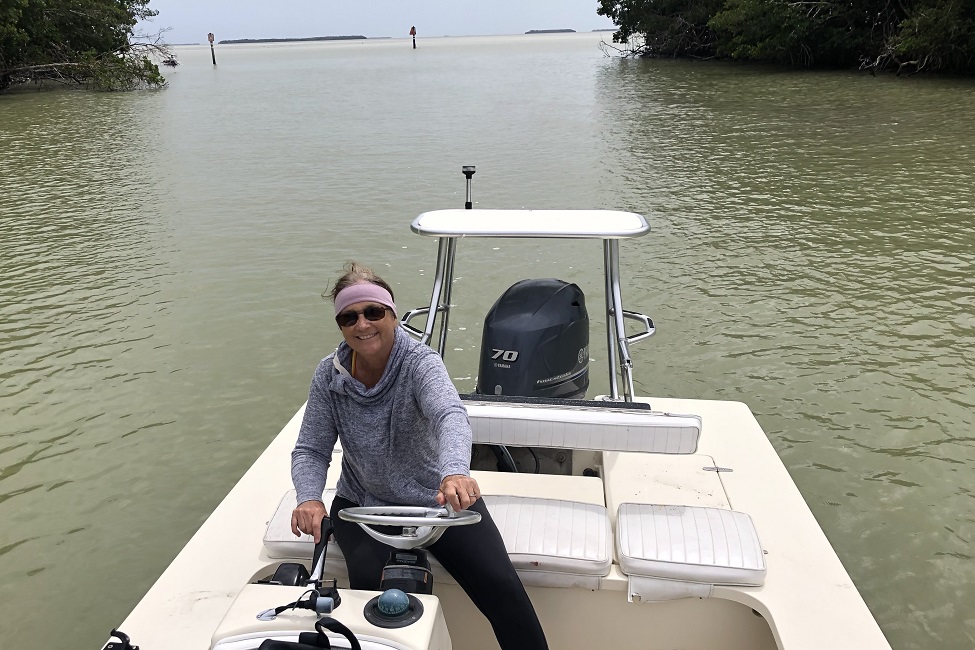Marine Seagrass Meadows Show Resilience to Bounce Back After Die-Offs

Marguerite Koch, Ph.D., in Florida Bay, which has experienced repeated biomass losses, including massive die-off events of turtlegrass, a marine seagrass.
In Florida alone, thousands of acres of marine seagrass beds have died. Major seagrass die-offs also are occurring around the world. Stressors such as high temperature, hypersalinity and hypoxia or lack of oxygen affect seagrasses’ ability to resist and recover from these stressor-related mortality events or when disturbances lead to seagrass die-off events.
Seagrass die-offs also are linked to exposure to sediment-derived hydrogen sulfide, a well-known phytotoxin that accumulates as seagrass ecosystems become more enriched in nutrients. While hydrogen sulfide intrusion into seagrass tissue is considered a leading cause of recurring mortality events, its effects on subsequent recruitment and distribution of new populations is unclear. Moreover, few studies have examined the ability of seagrass meadows’ resilience to “bounce back” and recolonize in open bare patches.
Researchers from Florida Atlantic University, in collaboration with the South Florida Water Management District, Coastal Ecosystems Division, examined if porewater hydrogen sulfide prevents Thalassia testudinum, a dominant tropical Atlantic-Caribbean marine seagrass known as turtlegrass, from recruiting into unvegetated sediment in Florida Bay. The bay is an estuary that covers about 1,100 square miles between the southern tip of Florida and the Florida Keys and is one of the largest global contiguous seagrass systems.
Since the 1980s, seagrass meadows in Florida Bay have experienced repeated biomass losses, including massive die-off events of turtlegrass, which typically occur during high temperature and salinity conditions in the northcentral and western bay. The bay provided an excellent case-study site due to high porewater hydrogen sulfide and expansive unvegetated areas adjacent to intact meadows that are recolonized by turtlegrass recruits following morality events.
For the study, researchers examined the leaf, stems and root tissue of turtlegrass in Florida Bay to establish tissue exposure to hydrogen sulfide in new recruits and measured internal hydrogen sulfide and oxygen dynamics using cutting-edge microsensors in the field and stable isotope analyses.
Results, published in the journal Aquatic Botany , provide evidence that turtlegrass can successfully recruit into open bare sediment following die-off events due to biomass partitioning – a process by which plants divide their energy among their leaves, stems, roots and reproductive parts – during early development, young root structure, and an ability to efficiently oxidize internally, which lowers hydrogen sulfide exposure. However, recovery of seagrass meadows takes time.
“Long-term monitoring programs in Florida Bay indicate that the time frame for full recovery of turtlegrass meadows after major die-off events is at least a decade,” said Marguerite Koch, Ph.D., senior author and a professor of biological sciences in FAU’s Charles E. Schmidt College of Science. “Therefore, preventing large-scale seagrass mortality events should be the management goal, particularly as global warming and associated stressors are likely to get more extreme in the future.”
Findings of the study indicate that recruiting shoot resistance to hydrogen sulfide exposure is linked to adequate oxidation of internal tissue during the day through late afternoon via photosynthesis and internal plant oxidation promoted by water column oxygen diffusion into the leaves at night, driven at times by tides. Limited belowground root development in new recruits potentially constrains microbial community development and associated sulfate reduction that decrease hydrogen sulfide intrusion into roots and negatively affecting sensitive growing tissue at the base of the seagrass leaves.
“Seagrass meadows sustain coastal ecosystems by protecting against erosion, maintaining water quality and providing habitat and food for many marine species and organisms,” said Koch. “Because of their importance in coastal communities, the current decline of seagrass ecosystems on a global scale across geographic regions is a concern.”
This research was funded by the United States Department of Interior (P18AC00812) and the South Florida Water Management District (PO 450-01-20159).
-FAU-
Latest News Desk
- The Runway at Florida Atlantic Announces 15th Venture ClassThe Runway at Florida Atlantic recently accepted 17 companies to participate in the 15th cohort of its Venture Program.
- FAU Receives Gift for Marta and Jim Batmasian Memorial PavilionFAU has announced a $500,000 gift from benefactors Marta and Jim Batmasian to name the Marta and Jim Batmasian Memorial Pavilion for the future Kurt and Marilyn Wallach Holocaust and Jewish Studies Building.
- FAU CARD Releases Free Water Safety Guide for Children with AutismDrowning is the top cause of unintentional death for children aged 1 to 4 in Florida, and autism increases the risk. FAU's CARD is offering a free guide to help protect children with autism from drowning.
- Fewer Parasites in Indian River Lagoon Signal Big Ecosystem ProblemsFAU Harbor Branch researchers used parasite data to assess the ecological health of Florida's Indian River Lagoon, which has suffered from pollution and algal blooms, damaging habitats like seagrass beds.
- From Students to Physicians: FAU Celebrates Graduating Class of 2025The Charles E. Schmidt College of Medicine celebrated the nation's newest physicians and biomedical researchers during its commencement ceremony today at the Carole and Barry Kaye Auditorium.
- FAU's Innovation Awards Celebrate Ingenuity, EntrepreneurshipFlorida Atlantic University's recent Innovation Awards awarded more than $55,000 in prizes across four innovation and entrepreneurship competitions.






